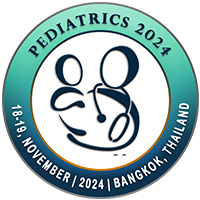
Hanan Said
International Medical Center, Saudi ArabiaTitle: Presentation 1: Closure of a Recurrent Urethrovaginal Fistula in a Girl with Cloacal Anomaly Using Deflux Injection | Presentation 2: Unique Thoracoscopic Technique for Posterolateral triangle repair in Congenital Diaphragmatic Hernia: A Bi-central study
Abstract
Presentation 1:
In a girl born with cloaca, both hemivaginae and rectum were located above the bladder neck, and both ureters were connected to the hemivaginae. After diverting colostomy and cystovaginoscopy on the second day of life, the repair of cloaca was performed at 10 months of age by posterior sagittal anorecto vaginoplasty (PSARVP), including laparotomy and bilateral ureteric reimplantation. Eight months after the surgery, she developed a vesicovaginal fistula, which was repaired and closed by open surgery through the bladder. Three months after this procedure, a tiny urethrovaginal fistula was noticed, which was closed at the age of 2 years using hook diathermy to refresh the edges and was then closed by Deflux injection. The proper closure of the urethrovaginal fistula was confirmed by radiology and cystoscopy 3 months after the surgery. This report shows that injection of Deflux into a tiny urethrovaginal fistula following refreshing the edges may be a valid treatment option in selected cases.
Presentation 2:
In a girl born with cloaca, both hemivaginae and rectum were located above the bladder neck, and both ureters were connected to the hemivaginae. After diverting colostomy and cystovaginoscopy on the second day of life, the repair of cloaca was performed at 10 months of age by posterior sagittal anorecto vaginoplasty (PSARVP), including laparotomy and bilateral ureteric reimplantation. Eight months after the surgery, she developed a vesicovaginal fistula, which was repaired and closed by open surgery through the bladder. Three months after this procedure, a tiny urethrovaginal fistula was noticed, which was closed at the age of 2 years using hook diathermy to refresh the edges and was then closed by Deflux injection. The proper closure of the urethrovaginal fistula was confirmed by radiology and cystoscopy 3 months after the surgery. This report shows that injection of Deflux into a tiny urethrovaginal fistula following refreshing the edges may be a valid treatment option in selected cases.
Presentation 2:
Background and Aim: Obstacle and complication of open conversion, hypercarbia and bowel, splenic injury in left side and Liver in right side have plagued Thoracoscopic repair. To evaluate our Unique technique for Posterolateral triangle the thoracoscopic repair of CDH with formulated preoperative specific selection criteria in two centers.
Methods: A bi-central, study, from June April 2017 to March 2023, neonates/Young infant were selected for unique thoracoscopic repair of CDH using physiological criteria (minimal Ventilatory support and no pre-operative clinical pulmonary hypertension) All repaired thoracoscopic using Ethibond 2/0-3/0, cases had difficulty for the posterolateral angle suturing repaired by endo-close devise by the same suturing material and tied extra-corporeal
Results: Forty one neonates with CDH were admitted to both center during the study period. Only 10 (24%) met selected criteria and went for thoracoscopic repair. Seven were left side and only one had right side CDH. All babies/young infant tolerated intrathoracic insufflation and CDH repair without clinically pulmonary hypertension, only 3 needed small mesh. Operative times ranged from 95 to 210 minutes. Post-operative ventilation ranged from 0 to 2 days. Longest follow up is 60 months. There has been no complication.
Conclusion: This unique technique of the posterolateral suturing enables a secure, fast, tension free repair. Neonatal thoracoscopic CDH repair is safe in selected patients who have a good preoperative pulmonary function
Conclusion: This unique technique of the posterolateral suturing enables a secure, fast, tension free repair. Neonatal thoracoscopic CDH repair is safe in selected patients who have a good preoperative pulmonary function
Biography
Paediatric Surgery Consultant and Paediatric Urology for more than 30 years International Advisor to the Royal College Physician and Surgeon of Glasgow in Saudi Arabia, Egypt and Sub-Saharan Africa.

